¿Se pregunta si elegir DTG vs Forma de impresión para su próximo proyecto de diseño personalizado??
It’;s a common question when you’;Re decidir cómo imprimir en la tela, y ambos métodos tienen sus propias fortalezas.
Dtg es ideal para detallado, diseños coloridos, Mientras que la impresión de seda de pantalla es ideal para pedidos más grandes y colores audaces. En este articulo, lo guiaremos a través de las diferencias clave entre los dos, para que pueda elegir la mejor opción para sus necesidades específicas.
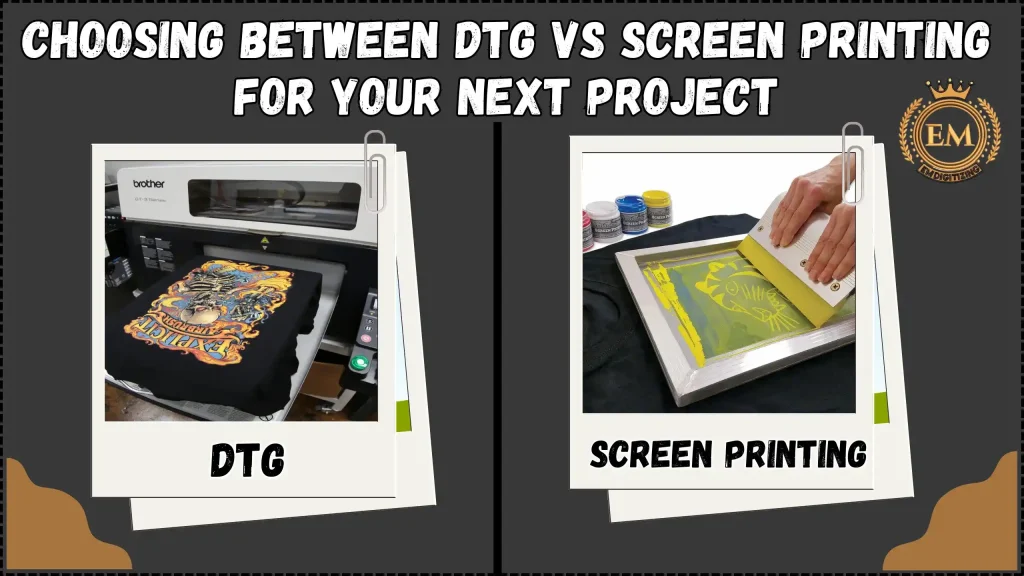
Explore qué método funcionará mejor para su proyecto!
Elegir entre DTG y serigrafía para su próximo proyecto
¿Qué es la impresión DTG??
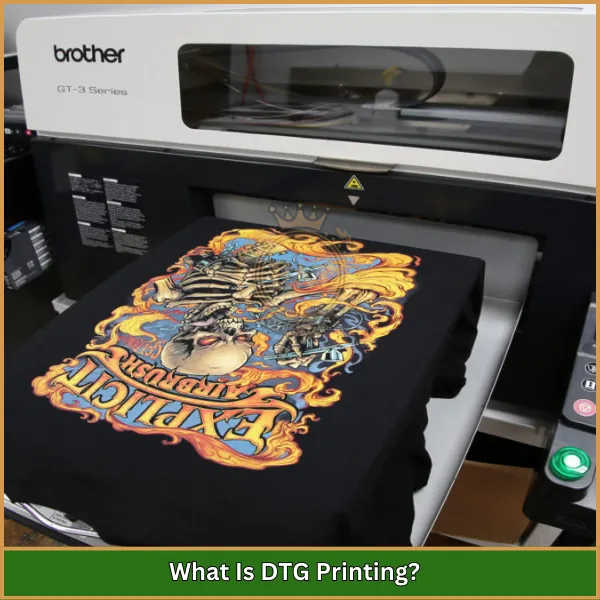
Directo a la prenda (DTG) La impresión es un método moderno que implica la impresión de diseños directamente en la tela utilizando una impresora especializada de inyección de tinta.
El proceso funciona de manera similar a cómo funciona una impresora de hogar regular, Pero en lugar de papel, se imprime en tela, principalmente camisetas.
La impresión DTG permite diseños de alta resolución con colores vibrantes y gráficos detallados, haciéndolo ideal para aquellos que desean diseños intrincados y coloridos en su ropa.
Ventajas clave
- Alta precisión de color y gradientes: La impresión DTG se destaca en el manejo de diseños complejos con intrincados gradientes de color y detalles. Es perfecto para obras de arte que requieren una amplia gama de colores y sombreado..
- Adecuado para pequeños pedidos: If you’;RE producir una pequeña cantidad de camisas o artículos personalizados, DTG is cost-effective because it doesn’;requiere mucho tiempo o materiales de preparación.
- Facilidad de personalización: DTG es perfecto para diseños o artículos únicos donde cada pieza necesita una ligera variación, tales como nombres o números personalizados en camisetas.
- Tiempo de configuración mínimo: A diferencia de impresión de seda, DTG printing doesn’;T requiere un largo proceso de configuración, haciéndolo una excelente opción para los pedidos ricos.
Desventajas
- Limitaciones con pedidos a granel: DTG no es rentable para pedidos grandes, ya que el costo por artículo sigue siendo relativamente alto en comparación con la impresión de seda, que se vuelve más barato con más unidades.
- Vida más corta de impresiones en ciertas telas: Las impresiones DTG pueden no durar tanto como los diseños impresos por la pantalla, especialmente en telas sintéticas. Lavar y usar puede causar desvanecimiento con el tiempo.
- Preferencias de material específicas (100% Algodón): DTG funciona mejor en 100% prendas de algodon. Es posible que no funcione bien en telas sintéticas como el poliéster, Limitar su versatilidad material.
¿Qué es la serigrafía??
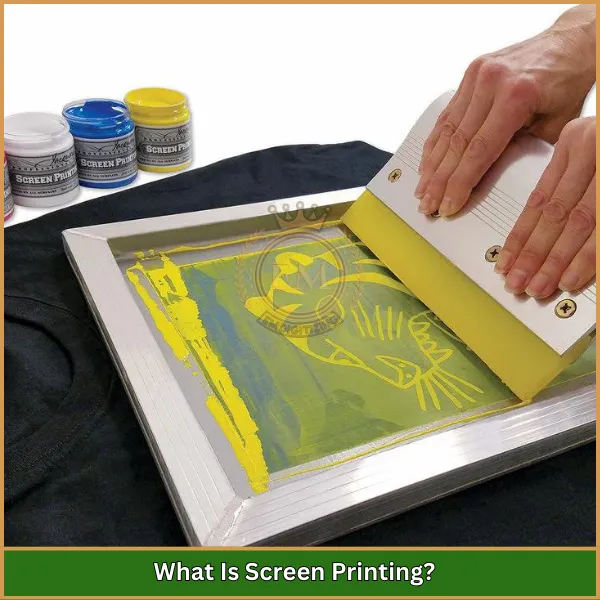
También se conoce como impresión de silscreen, es un método tradicional que ha existido durante décadas. Implica usar plantillas (o "pantallas") para presionar la tinta sobre la tela en capas.
Cada color en el diseño requiere una pantalla separada, convirtiéndolo en un proceso más lento, Pero los resultados son duraderos y vibrantes.
Ventajas clave
- Ideal para la impresión a granel: Se vuelve más económico con pedidos más grandes porque el costo de configuración se extiende en muchas unidades., reduciendo el costo por artículo.
- Rico, Colores vibrantes: Este método produce colores altamente saturados y opacos., que son excelentes para diseños audaces que necesitan destacar en cualquier tela.
- Eficiencia de rentabilidad para lotes grandes: Una vez que las pantallas están configuradas, El proceso de impresión real es rápido, haciéndolo muy rentable para las carreras de impresión grande.
- Versatilidad en diferentes materiales: Se puede aplicar a una amplia gama de materiales, incluido el algodón, poliéster, metal, vaso, madera, y más.
Desventajas
- Tiempo de configuración largo: Cada color en el diseño requiere una pantalla separada, que lleva tiempo prepararse. Esto lo hace menos eficiente para pedidos pequeños o únicos.
- Más costoso para pedidos más pequeños: Los costos de configuración de este método de impresión pueden hacer que sea costoso para pequeñas ejecuciones de impresión. El precio por unidad disminuye con mayores cantidades, pero sigue siendo alto para trabajos más pequeños..
- Capacidades limitadas de color y detalle: Mientras que es ideal para colores audaces y sólidos, Lucha con detalles intrincados y gradientes complejos que DTG puede manejar fácilmente.
Diferencia clave entre DTG vs Impresión de pantalla
Vamos a sumergirnos en las diferencias clave entre la impresión de pantalla DTG vs, para que pueda tomar la mejor decisión para sus necesidades.
Proceso de impresión y tiempo de configuración

DTG utiliza un proceso sencillo de inyección de tinta que imprime directamente en la tela con una configuración mínima, haciéndolo ideal para trabajos rápidos y pedidos pequeños. Este proceso permite aplicar diseños detallados y una amplia gama de colores sin mucha preparación..
Por otro lado, La impresión de seda de pantalla requiere la preparación de múltiples pantallas para cada color, que aumenta significativamente el tiempo de configuración. Para diseños complejos de múltiples colores, La impresión de seda de pantalla puede llevar mucho tiempo, pero se vuelve eficiente cuando se produce a granel.
Esta diferencia en la configuración hace que la impresión DTG versus la impresión de la pantalla sea una consideración clave, especially if you’;Re en un horario apretado.
Rentabilidad para diferentes volúmenes
Uno de los principales factores a considerar es la rentabilidad. La impresión de la pantalla se vuelve más económica a medida que aumenta el volumen ya que el costo por unidad disminuye una vez que se configuran las pantallas. Por eso es el método de referencia para lotes más grandes de ropa personalizada.
A diferencia de, DTG es más adecuado para pedidos más pequeños porque no requiere una configuración costosa, Pero el costo por unidad sigue siendo mayor para grandes cantidades. If you’;Re decidir entre DTG y la impresión de pantalla para un pedido masivo, La impresión en la pantalla probablemente será la opción más económica.
Durabilidad y longevidad de las impresiones
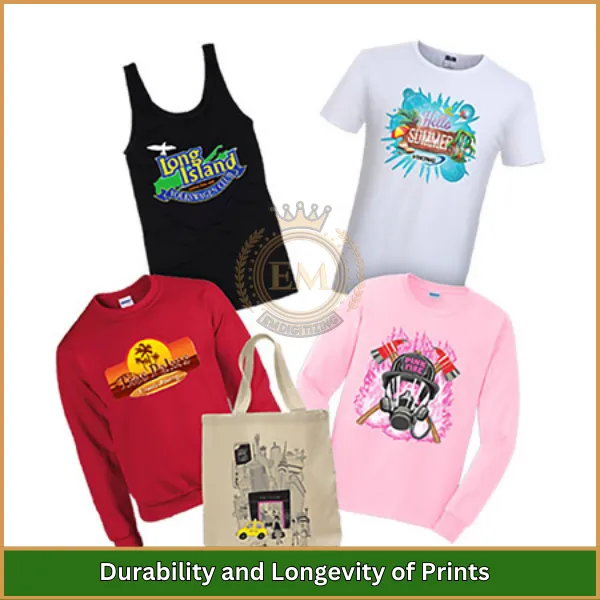
La durabilidad de la impresión de pantalla DTG vs es otro punto crucial. La impresión en la pantalla generalmente produce impresiones que son más duraderas y duraderas.
La tinta utilizada en la impresión de seda de la pantalla penetra profundamente en la tela, haciéndolo resistente al lavado y el desvanecimiento con el tiempo.
Impresiones DTG, mientras que capaz de producir imágenes vibrantes y detalladas, puede desvanecerse más rápidamente con el lavado repetido, especialmente si no cuidan correctamente.
Para prendas que se someterán a ropa frecuente y lavado, su contraparte es a menudo la opción más duradera.
Versatilidad en el uso de telas y materiales
Cuando se trata de opciones de tela, La impresión de pantalla ofrece más versatilidad. Este método se puede usar en una amplia gama de materiales., incluido el algodón, poliéster, cuero, e incluso superficies no fabricales como madera o metal.
DTG, sin embargo, Funciona mejor en telas de algodón y algodón debido a la forma en que la tinta se adhiere al material. Esto limita la aplicación de DTG a ciertos tipos de prendas y proyectos, Hacer la impresión en la pantalla la opción superior para diversos tipos de telas.
Capacidades de color y diseño
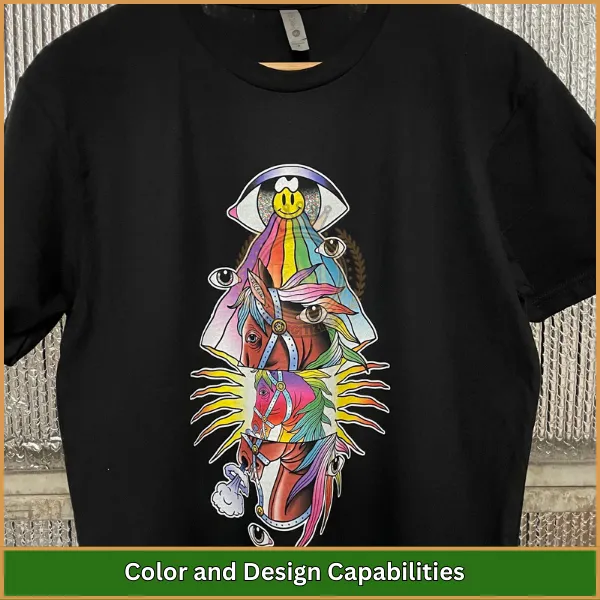
Para diseños intrincados con muchos colores, DTG realmente brilla. Maneja patrones complejos, Gradientes de color, e imágenes detalladas con facilidad, Producir impresiones de alta resolución que pueden replicar casi cualquier diseño. A diferencia de, La impresión de seda de pantalla es más adecuada para negrita, Colores sólidos.
Mientras que puede producir diseños multicolor, Cada color adicional requiere una pantalla separada, que puede aumentar el tiempo y el costo del proyecto.
Al comparar DTG y la calidad de la impresión de pantalla, DTG es la mejor opción para diseños que requieren un alto nivel de detalle y muchos colores, mientras que su contraparte es ideal para más simple, Diseños más audaces.
Las mejores situaciones para usar DTG VS Pantalla Impresión
Las mejores situaciones | DTG | Impresión de pantalla |
Tamaño de pedido | Pedidos pequeños a medianos | Pedidos de gran volumen |
Complejidad del diseño | Alta resolución, detallado, y multicolor | Simple, Diseños en negrita con menos colores |
Tiempo de respuesta | Producción rápida, configuración mínima | Configuración más larga, Más rápido para grandes cantidades |
Idoneidad de material | Mejor para 100% mezclas de algodón y algodón | Trabaja en una amplia gama de materiales (p.ej., poliéster, cuero, etc.) |
Rentabilidad | Más rentable para carreras pequeñas | Más económico para las órdenes a granel |
Durabilidad | La durabilidad moderada puede desvanecerse con el lavado | Muy duradero, impresiones duraderas |
personalización | Ideal para personalizado, diseños únicos | Más adecuado para diseños repetidos y producción en masa |
Impacto medioambiental | Utiliza tintas a base de agua, ecológico para lotes pequeños | Desechos de tinta más grandes, No es tan amigable con el medio ambiente para pedidos pequeños |
Línea de fondo
Elegir entre DTG y la impresión de pantalla depende de lo que necesite. Dtg es ideal para pequeño, diseños coloridos, mientras que otro método de impresión funciona mejor para grandes pedidos con diseños simples. Saber la diferencia te ayuda a elegir el adecuado para tu proyecto.
A EMdigitalización, Podemos ayudar a hacer que sus diseños sean perfectos para imprimir con nuestro Servicios de vector. Trabajamos rápido, ofrecer precios asequibles, y asegúrese de que sus diseños se vean geniales! Más, if it’;es tu primera vez con nosotros, usted obtiene 50% apagado.
Déjanos ayudarte a crear algo increíble!
preguntas frecuentes
La impresión DTG generalmente no dura tanto como la impresión de la pantalla. La impresión de pantalla generalmente ofrece resultados más duraderos y vibrantes que pueden soportar el lavado y el desgaste repetidos con el tiempo.
Sí, La impresión DTG tiende a ser más costosa que la impresión de pantalla, especialmente para pedidos más grandes. Esto se debe a que DTG requiere equipos y materiales más caros., haciéndolo menos rentable para trabajos de alto volumen.
Sí, DTG funciona mejor en 100% algodón y otras telas naturales. Produce de alta calidad, Impresiones detalladas sobre estos materiales, haciéndolo ideal para ropa de algodón.
Las impresiones DTG pueden desvanecerse con el tiempo, especialmente con lavado frecuente. Sin embargo, Si se toma el cuidado adecuado, como lavar de adentro hacia afuera y evitar detergentes duros, Las impresiones pueden durar más.
